IT 210 Final Project: Business Systems Analysis and Technologies
VerifiedAdded on 2022/08/24
|8
|1963
|14
Project
AI Summary
This project analyzes a small brick-and-mortar business specializing in designer clothing, shoes, and handbags, aiming to integrate its operations with e-commerce. The analysis focuses on the problem of limited online presence and competition from major e-retailers like Zappos and Macy's. The project explores the application of cloud computing and big data, including knowledge management, to streamline business processes such as inventory management, online payments, and customer relationship management. It outlines business requirements, project objectives, and technology requirements, while also examining the technology adoption strategies of key competitors like Nordstrom Rack and Kohl's. The project emphasizes the benefits of these technologies, such as improved forecasting and enhanced customer engagement. The assignment provides an overview of the business's needs, the technologies chosen to address them, and the competitive landscape.
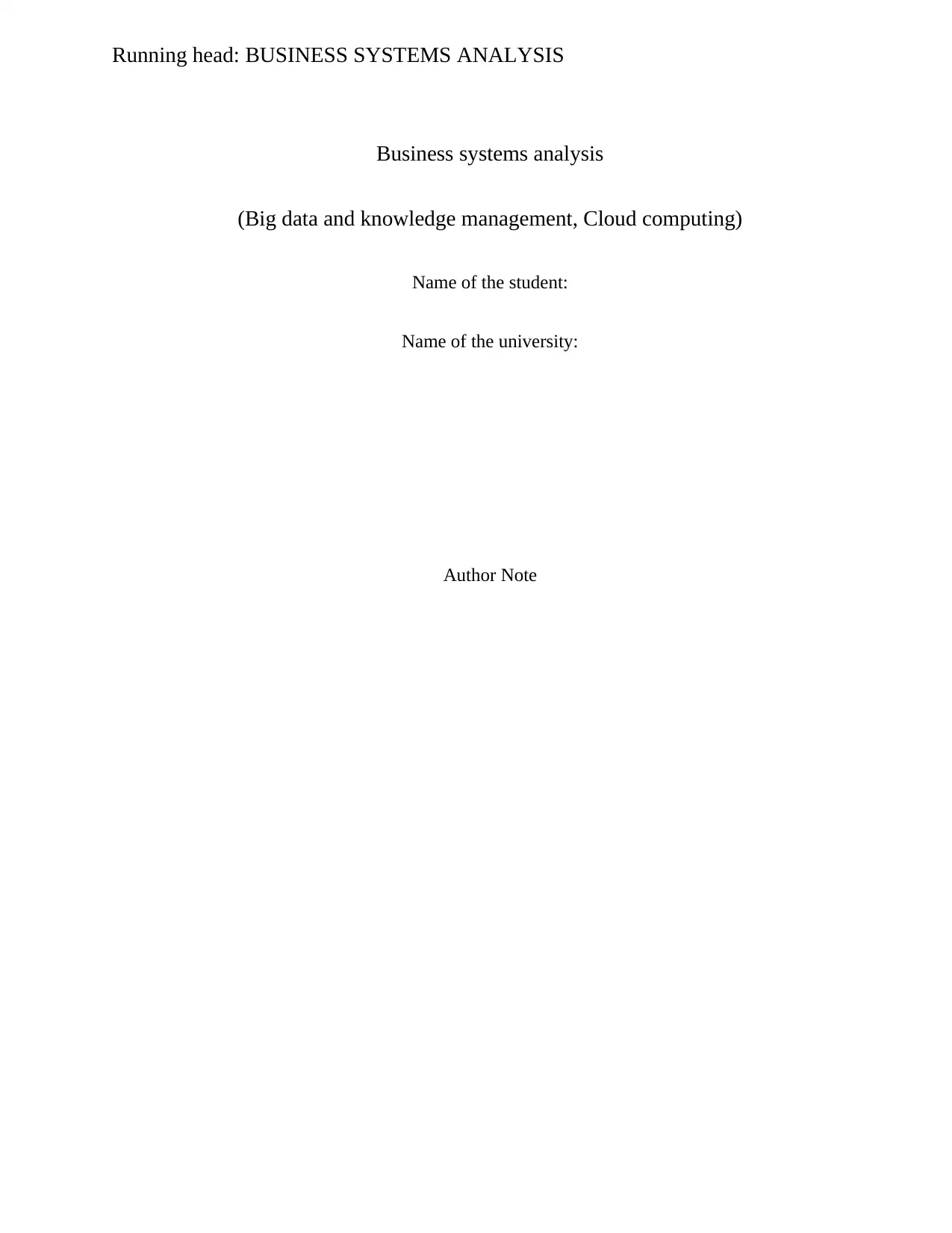
Running head: BUSINESS SYSTEMS ANALYSIS
Business systems analysis
(Big data and knowledge management, Cloud computing)
Name of the student:
Name of the university:
Author Note
Business systems analysis
(Big data and knowledge management, Cloud computing)
Name of the student:
Name of the university:
Author Note
Paraphrase This Document
Need a fresh take? Get an instant paraphrase of this document with our AI Paraphraser
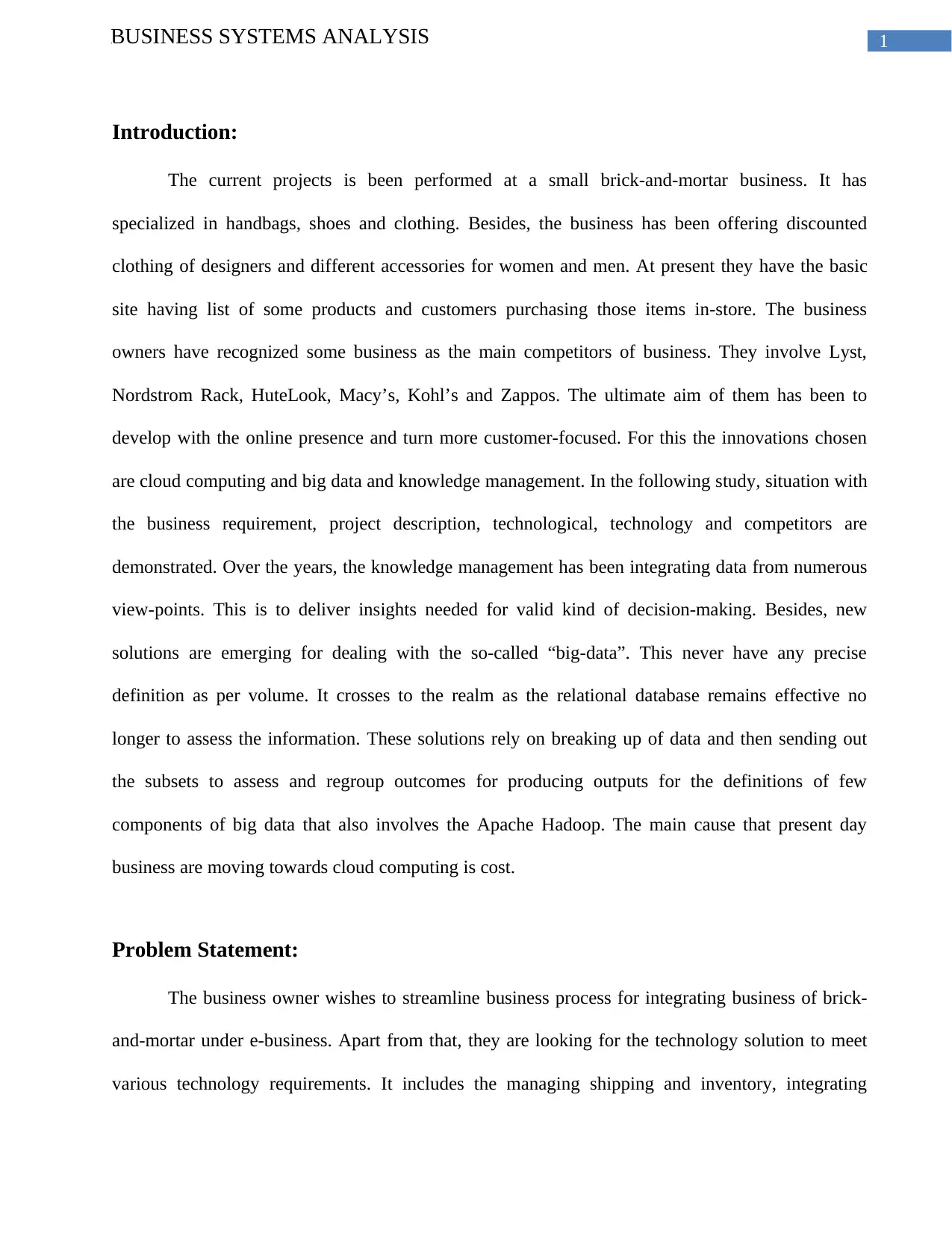
1BUSINESS SYSTEMS ANALYSIS
Introduction:
The current projects is been performed at a small brick-and-mortar business. It has
specialized in handbags, shoes and clothing. Besides, the business has been offering discounted
clothing of designers and different accessories for women and men. At present they have the basic
site having list of some products and customers purchasing those items in-store. The business
owners have recognized some business as the main competitors of business. They involve Lyst,
Nordstrom Rack, HuteLook, Macy’s, Kohl’s and Zappos. The ultimate aim of them has been to
develop with the online presence and turn more customer-focused. For this the innovations chosen
are cloud computing and big data and knowledge management. In the following study, situation with
the business requirement, project description, technological, technology and competitors are
demonstrated. Over the years, the knowledge management has been integrating data from numerous
view-points. This is to deliver insights needed for valid kind of decision-making. Besides, new
solutions are emerging for dealing with the so-called “big-data”. This never have any precise
definition as per volume. It crosses to the realm as the relational database remains effective no
longer to assess the information. These solutions rely on breaking up of data and then sending out
the subsets to assess and regroup outcomes for producing outputs for the definitions of few
components of big data that also involves the Apache Hadoop. The main cause that present day
business are moving towards cloud computing is cost.
Problem Statement:
The business owner wishes to streamline business process for integrating business of brick-
and-mortar under e-business. Apart from that, they are looking for the technology solution to meet
various technology requirements. It includes the managing shipping and inventory, integrating
Introduction:
The current projects is been performed at a small brick-and-mortar business. It has
specialized in handbags, shoes and clothing. Besides, the business has been offering discounted
clothing of designers and different accessories for women and men. At present they have the basic
site having list of some products and customers purchasing those items in-store. The business
owners have recognized some business as the main competitors of business. They involve Lyst,
Nordstrom Rack, HuteLook, Macy’s, Kohl’s and Zappos. The ultimate aim of them has been to
develop with the online presence and turn more customer-focused. For this the innovations chosen
are cloud computing and big data and knowledge management. In the following study, situation with
the business requirement, project description, technological, technology and competitors are
demonstrated. Over the years, the knowledge management has been integrating data from numerous
view-points. This is to deliver insights needed for valid kind of decision-making. Besides, new
solutions are emerging for dealing with the so-called “big-data”. This never have any precise
definition as per volume. It crosses to the realm as the relational database remains effective no
longer to assess the information. These solutions rely on breaking up of data and then sending out
the subsets to assess and regroup outcomes for producing outputs for the definitions of few
components of big data that also involves the Apache Hadoop. The main cause that present day
business are moving towards cloud computing is cost.
Problem Statement:
The business owner wishes to streamline business process for integrating business of brick-
and-mortar under e-business. Apart from that, they are looking for the technology solution to meet
various technology requirements. It includes the managing shipping and inventory, integrating
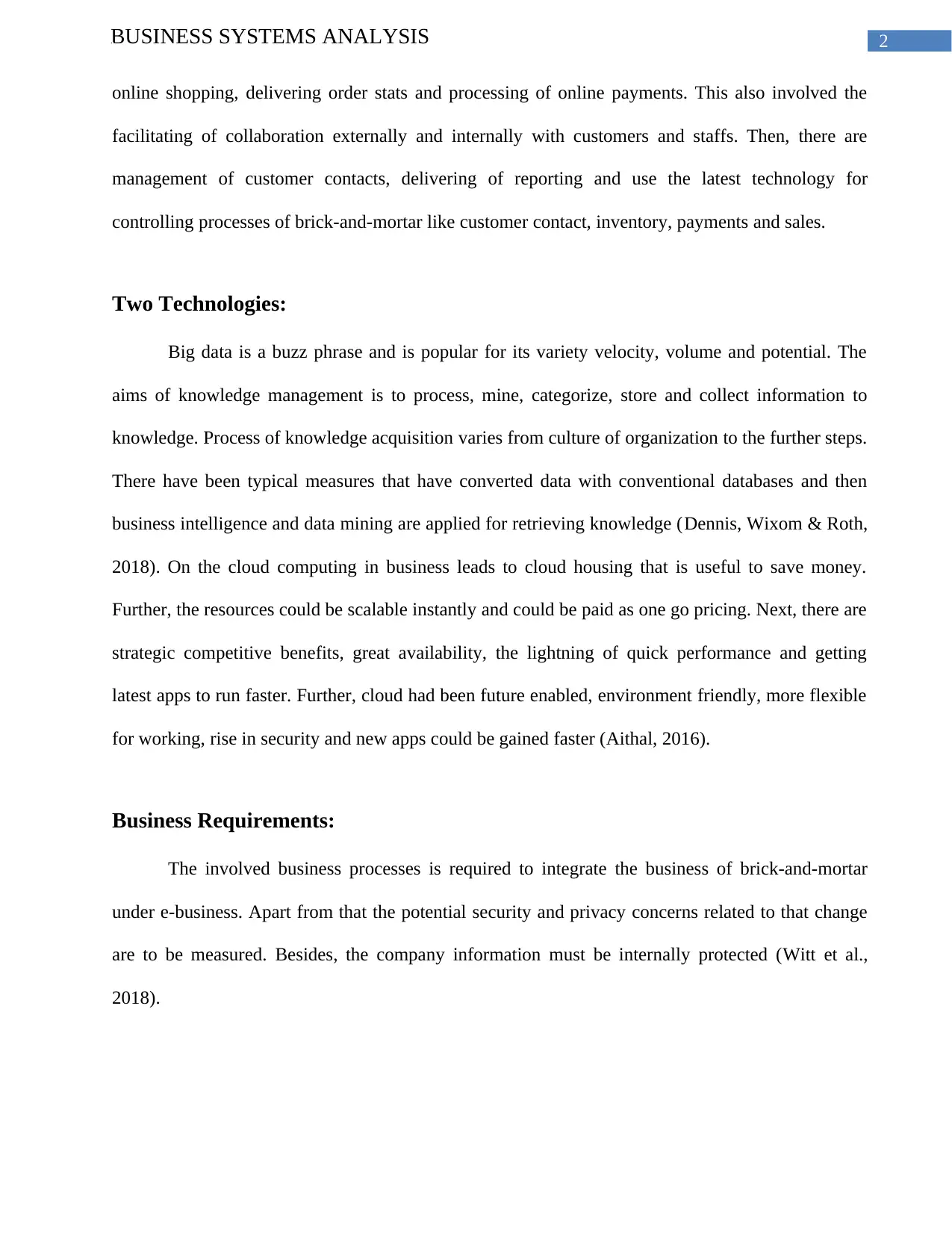
2BUSINESS SYSTEMS ANALYSIS
online shopping, delivering order stats and processing of online payments. This also involved the
facilitating of collaboration externally and internally with customers and staffs. Then, there are
management of customer contacts, delivering of reporting and use the latest technology for
controlling processes of brick-and-mortar like customer contact, inventory, payments and sales.
Two Technologies:
Big data is a buzz phrase and is popular for its variety velocity, volume and potential. The
aims of knowledge management is to process, mine, categorize, store and collect information to
knowledge. Process of knowledge acquisition varies from culture of organization to the further steps.
There have been typical measures that have converted data with conventional databases and then
business intelligence and data mining are applied for retrieving knowledge (Dennis, Wixom & Roth,
2018). On the cloud computing in business leads to cloud housing that is useful to save money.
Further, the resources could be scalable instantly and could be paid as one go pricing. Next, there are
strategic competitive benefits, great availability, the lightning of quick performance and getting
latest apps to run faster. Further, cloud had been future enabled, environment friendly, more flexible
for working, rise in security and new apps could be gained faster (Aithal, 2016).
Business Requirements:
The involved business processes is required to integrate the business of brick-and-mortar
under e-business. Apart from that the potential security and privacy concerns related to that change
are to be measured. Besides, the company information must be internally protected (Witt et al.,
2018).
online shopping, delivering order stats and processing of online payments. This also involved the
facilitating of collaboration externally and internally with customers and staffs. Then, there are
management of customer contacts, delivering of reporting and use the latest technology for
controlling processes of brick-and-mortar like customer contact, inventory, payments and sales.
Two Technologies:
Big data is a buzz phrase and is popular for its variety velocity, volume and potential. The
aims of knowledge management is to process, mine, categorize, store and collect information to
knowledge. Process of knowledge acquisition varies from culture of organization to the further steps.
There have been typical measures that have converted data with conventional databases and then
business intelligence and data mining are applied for retrieving knowledge (Dennis, Wixom & Roth,
2018). On the cloud computing in business leads to cloud housing that is useful to save money.
Further, the resources could be scalable instantly and could be paid as one go pricing. Next, there are
strategic competitive benefits, great availability, the lightning of quick performance and getting
latest apps to run faster. Further, cloud had been future enabled, environment friendly, more flexible
for working, rise in security and new apps could be gained faster (Aithal, 2016).
Business Requirements:
The involved business processes is required to integrate the business of brick-and-mortar
under e-business. Apart from that the potential security and privacy concerns related to that change
are to be measured. Besides, the company information must be internally protected (Witt et al.,
2018).
⊘ This is a preview!⊘
Do you want full access?
Subscribe today to unlock all pages.

Trusted by 1+ million students worldwide
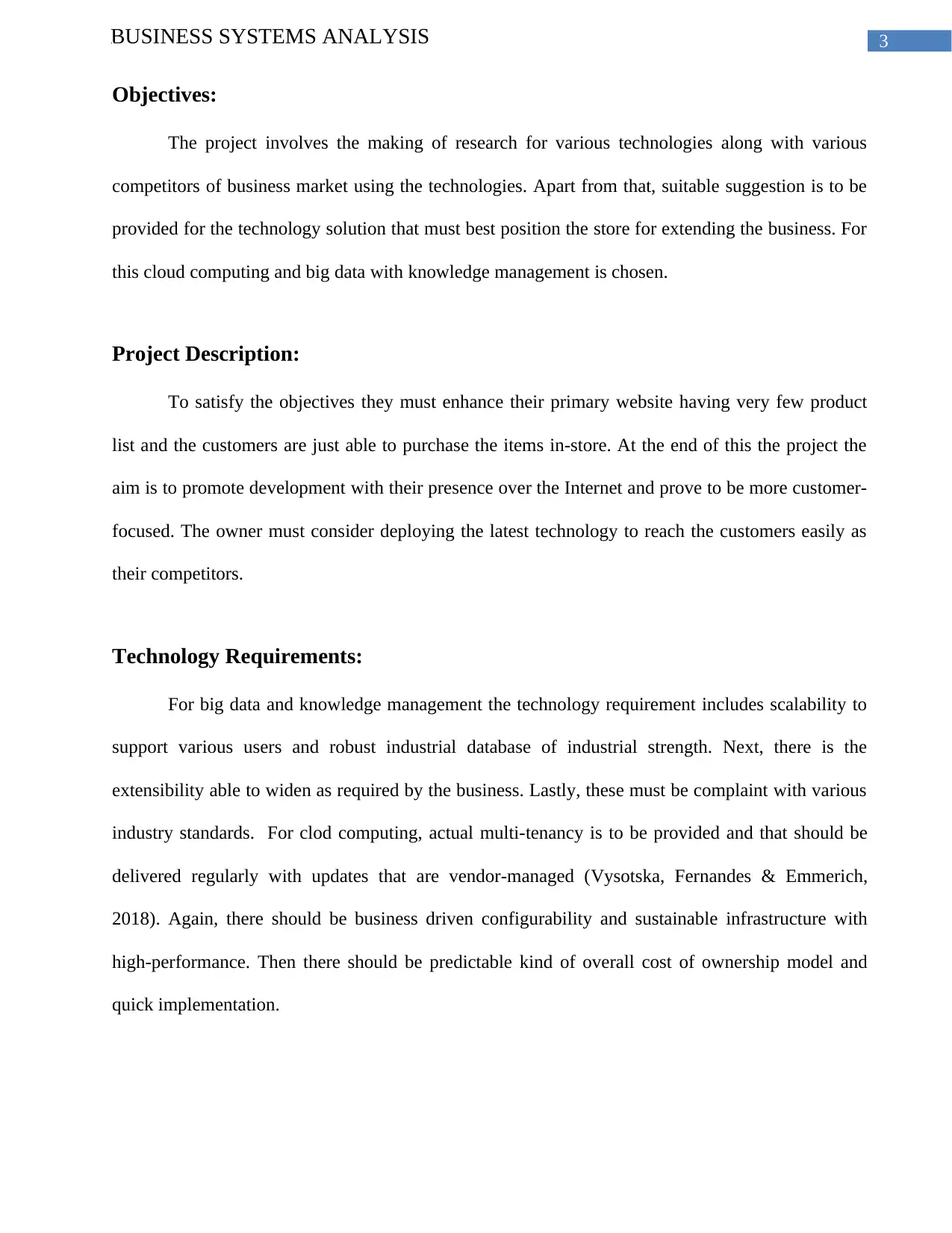
3BUSINESS SYSTEMS ANALYSIS
Objectives:
The project involves the making of research for various technologies along with various
competitors of business market using the technologies. Apart from that, suitable suggestion is to be
provided for the technology solution that must best position the store for extending the business. For
this cloud computing and big data with knowledge management is chosen.
Project Description:
To satisfy the objectives they must enhance their primary website having very few product
list and the customers are just able to purchase the items in-store. At the end of this the project the
aim is to promote development with their presence over the Internet and prove to be more customer-
focused. The owner must consider deploying the latest technology to reach the customers easily as
their competitors.
Technology Requirements:
For big data and knowledge management the technology requirement includes scalability to
support various users and robust industrial database of industrial strength. Next, there is the
extensibility able to widen as required by the business. Lastly, these must be complaint with various
industry standards. For clod computing, actual multi-tenancy is to be provided and that should be
delivered regularly with updates that are vendor-managed (Vysotska, Fernandes & Emmerich,
2018). Again, there should be business driven configurability and sustainable infrastructure with
high-performance. Then there should be predictable kind of overall cost of ownership model and
quick implementation.
Objectives:
The project involves the making of research for various technologies along with various
competitors of business market using the technologies. Apart from that, suitable suggestion is to be
provided for the technology solution that must best position the store for extending the business. For
this cloud computing and big data with knowledge management is chosen.
Project Description:
To satisfy the objectives they must enhance their primary website having very few product
list and the customers are just able to purchase the items in-store. At the end of this the project the
aim is to promote development with their presence over the Internet and prove to be more customer-
focused. The owner must consider deploying the latest technology to reach the customers easily as
their competitors.
Technology Requirements:
For big data and knowledge management the technology requirement includes scalability to
support various users and robust industrial database of industrial strength. Next, there is the
extensibility able to widen as required by the business. Lastly, these must be complaint with various
industry standards. For clod computing, actual multi-tenancy is to be provided and that should be
delivered regularly with updates that are vendor-managed (Vysotska, Fernandes & Emmerich,
2018). Again, there should be business driven configurability and sustainable infrastructure with
high-performance. Then there should be predictable kind of overall cost of ownership model and
quick implementation.
Paraphrase This Document
Need a fresh take? Get an instant paraphrase of this document with our AI Paraphraser
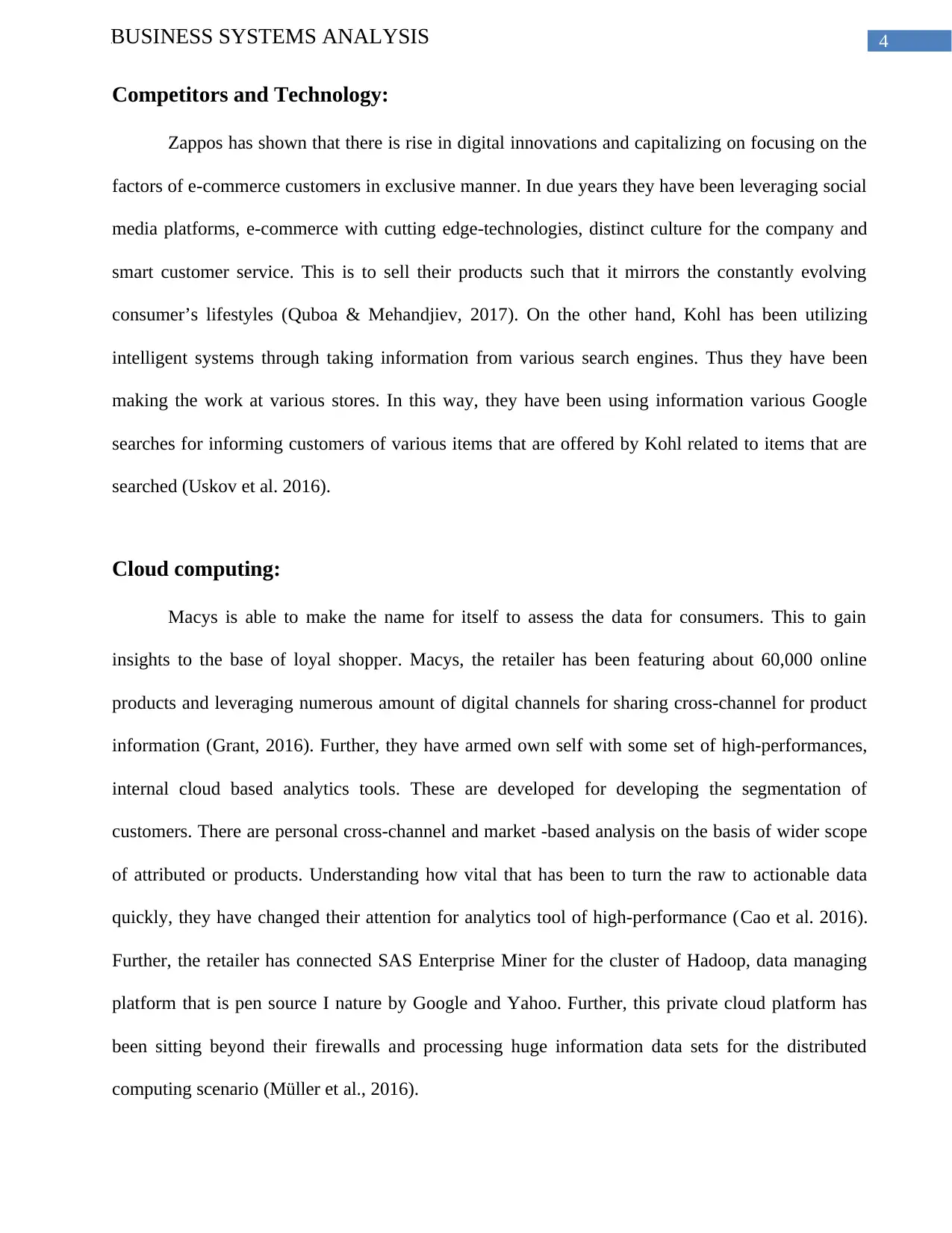
4BUSINESS SYSTEMS ANALYSIS
Competitors and Technology:
Zappos has shown that there is rise in digital innovations and capitalizing on focusing on the
factors of e-commerce customers in exclusive manner. In due years they have been leveraging social
media platforms, e-commerce with cutting edge-technologies, distinct culture for the company and
smart customer service. This is to sell their products such that it mirrors the constantly evolving
consumer’s lifestyles (Quboa & Mehandjiev, 2017). On the other hand, Kohl has been utilizing
intelligent systems through taking information from various search engines. Thus they have been
making the work at various stores. In this way, they have been using information various Google
searches for informing customers of various items that are offered by Kohl related to items that are
searched (Uskov et al. 2016).
Cloud computing:
Macys is able to make the name for itself to assess the data for consumers. This to gain
insights to the base of loyal shopper. Macys, the retailer has been featuring about 60,000 online
products and leveraging numerous amount of digital channels for sharing cross-channel for product
information (Grant, 2016). Further, they have armed own self with some set of high-performances,
internal cloud based analytics tools. These are developed for developing the segmentation of
customers. There are personal cross-channel and market -based analysis on the basis of wider scope
of attributed or products. Understanding how vital that has been to turn the raw to actionable data
quickly, they have changed their attention for analytics tool of high-performance (Cao et al. 2016).
Further, the retailer has connected SAS Enterprise Miner for the cluster of Hadoop, data managing
platform that is pen source I nature by Google and Yahoo. Further, this private cloud platform has
been sitting beyond their firewalls and processing huge information data sets for the distributed
computing scenario (Müller et al., 2016).
Competitors and Technology:
Zappos has shown that there is rise in digital innovations and capitalizing on focusing on the
factors of e-commerce customers in exclusive manner. In due years they have been leveraging social
media platforms, e-commerce with cutting edge-technologies, distinct culture for the company and
smart customer service. This is to sell their products such that it mirrors the constantly evolving
consumer’s lifestyles (Quboa & Mehandjiev, 2017). On the other hand, Kohl has been utilizing
intelligent systems through taking information from various search engines. Thus they have been
making the work at various stores. In this way, they have been using information various Google
searches for informing customers of various items that are offered by Kohl related to items that are
searched (Uskov et al. 2016).
Cloud computing:
Macys is able to make the name for itself to assess the data for consumers. This to gain
insights to the base of loyal shopper. Macys, the retailer has been featuring about 60,000 online
products and leveraging numerous amount of digital channels for sharing cross-channel for product
information (Grant, 2016). Further, they have armed own self with some set of high-performances,
internal cloud based analytics tools. These are developed for developing the segmentation of
customers. There are personal cross-channel and market -based analysis on the basis of wider scope
of attributed or products. Understanding how vital that has been to turn the raw to actionable data
quickly, they have changed their attention for analytics tool of high-performance (Cao et al. 2016).
Further, the retailer has connected SAS Enterprise Miner for the cluster of Hadoop, data managing
platform that is pen source I nature by Google and Yahoo. Further, this private cloud platform has
been sitting beyond their firewalls and processing huge information data sets for the distributed
computing scenario (Müller et al., 2016).
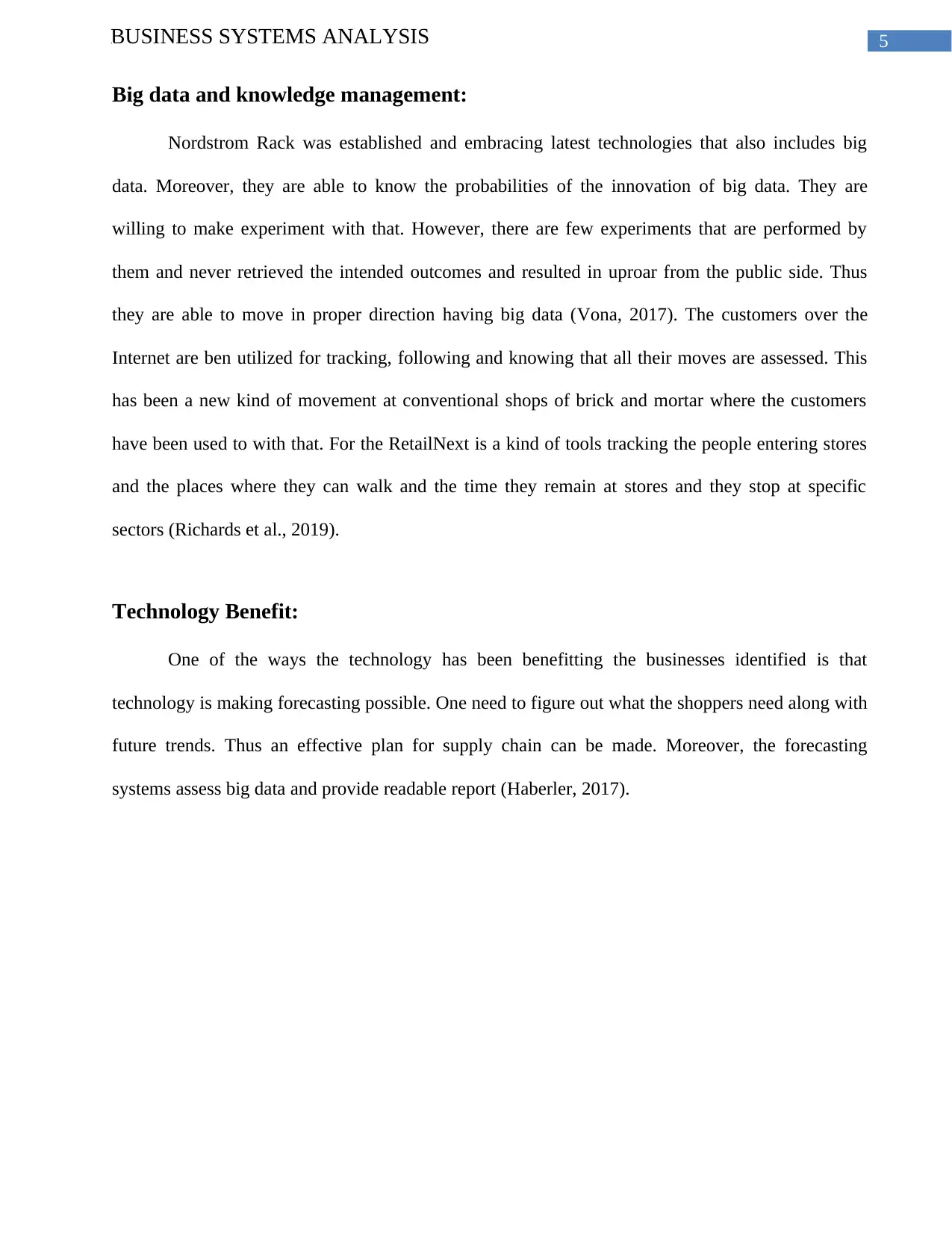
5BUSINESS SYSTEMS ANALYSIS
Big data and knowledge management:
Nordstrom Rack was established and embracing latest technologies that also includes big
data. Moreover, they are able to know the probabilities of the innovation of big data. They are
willing to make experiment with that. However, there are few experiments that are performed by
them and never retrieved the intended outcomes and resulted in uproar from the public side. Thus
they are able to move in proper direction having big data (Vona, 2017). The customers over the
Internet are ben utilized for tracking, following and knowing that all their moves are assessed. This
has been a new kind of movement at conventional shops of brick and mortar where the customers
have been used to with that. For the RetailNext is a kind of tools tracking the people entering stores
and the places where they can walk and the time they remain at stores and they stop at specific
sectors (Richards et al., 2019).
Technology Benefit:
One of the ways the technology has been benefitting the businesses identified is that
technology is making forecasting possible. One need to figure out what the shoppers need along with
future trends. Thus an effective plan for supply chain can be made. Moreover, the forecasting
systems assess big data and provide readable report (Haberler, 2017).
Big data and knowledge management:
Nordstrom Rack was established and embracing latest technologies that also includes big
data. Moreover, they are able to know the probabilities of the innovation of big data. They are
willing to make experiment with that. However, there are few experiments that are performed by
them and never retrieved the intended outcomes and resulted in uproar from the public side. Thus
they are able to move in proper direction having big data (Vona, 2017). The customers over the
Internet are ben utilized for tracking, following and knowing that all their moves are assessed. This
has been a new kind of movement at conventional shops of brick and mortar where the customers
have been used to with that. For the RetailNext is a kind of tools tracking the people entering stores
and the places where they can walk and the time they remain at stores and they stop at specific
sectors (Richards et al., 2019).
Technology Benefit:
One of the ways the technology has been benefitting the businesses identified is that
technology is making forecasting possible. One need to figure out what the shoppers need along with
future trends. Thus an effective plan for supply chain can be made. Moreover, the forecasting
systems assess big data and provide readable report (Haberler, 2017).
⊘ This is a preview!⊘
Do you want full access?
Subscribe today to unlock all pages.

Trusted by 1+ million students worldwide
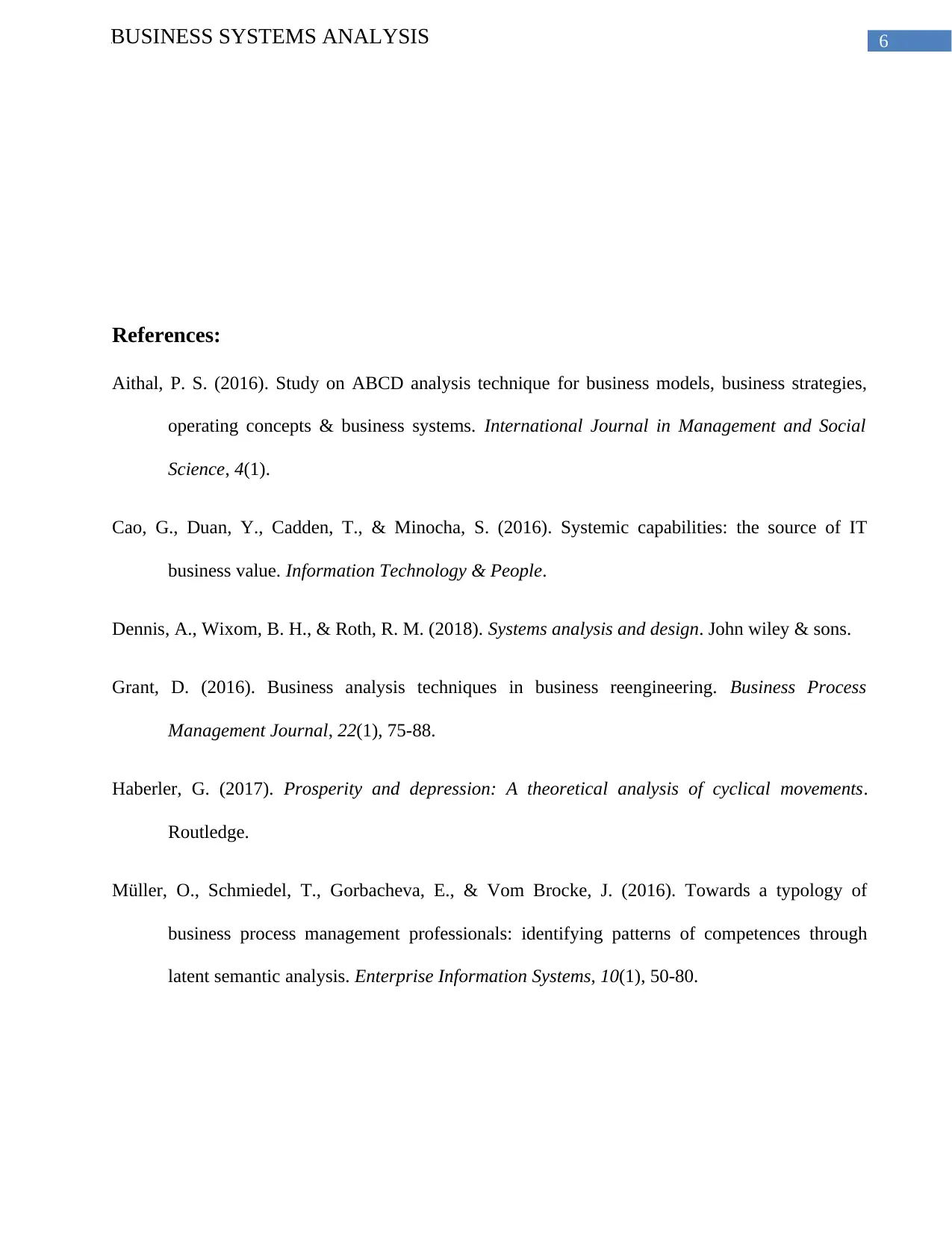
6BUSINESS SYSTEMS ANALYSIS
References:
Aithal, P. S. (2016). Study on ABCD analysis technique for business models, business strategies,
operating concepts & business systems. International Journal in Management and Social
Science, 4(1).
Cao, G., Duan, Y., Cadden, T., & Minocha, S. (2016). Systemic capabilities: the source of IT
business value. Information Technology & People.
Dennis, A., Wixom, B. H., & Roth, R. M. (2018). Systems analysis and design. John wiley & sons.
Grant, D. (2016). Business analysis techniques in business reengineering. Business Process
Management Journal, 22(1), 75-88.
Haberler, G. (2017). Prosperity and depression: A theoretical analysis of cyclical movements.
Routledge.
Müller, O., Schmiedel, T., Gorbacheva, E., & Vom Brocke, J. (2016). Towards a typology of
business process management professionals: identifying patterns of competences through
latent semantic analysis. Enterprise Information Systems, 10(1), 50-80.
References:
Aithal, P. S. (2016). Study on ABCD analysis technique for business models, business strategies,
operating concepts & business systems. International Journal in Management and Social
Science, 4(1).
Cao, G., Duan, Y., Cadden, T., & Minocha, S. (2016). Systemic capabilities: the source of IT
business value. Information Technology & People.
Dennis, A., Wixom, B. H., & Roth, R. M. (2018). Systems analysis and design. John wiley & sons.
Grant, D. (2016). Business analysis techniques in business reengineering. Business Process
Management Journal, 22(1), 75-88.
Haberler, G. (2017). Prosperity and depression: A theoretical analysis of cyclical movements.
Routledge.
Müller, O., Schmiedel, T., Gorbacheva, E., & Vom Brocke, J. (2016). Towards a typology of
business process management professionals: identifying patterns of competences through
latent semantic analysis. Enterprise Information Systems, 10(1), 50-80.
Paraphrase This Document
Need a fresh take? Get an instant paraphrase of this document with our AI Paraphraser
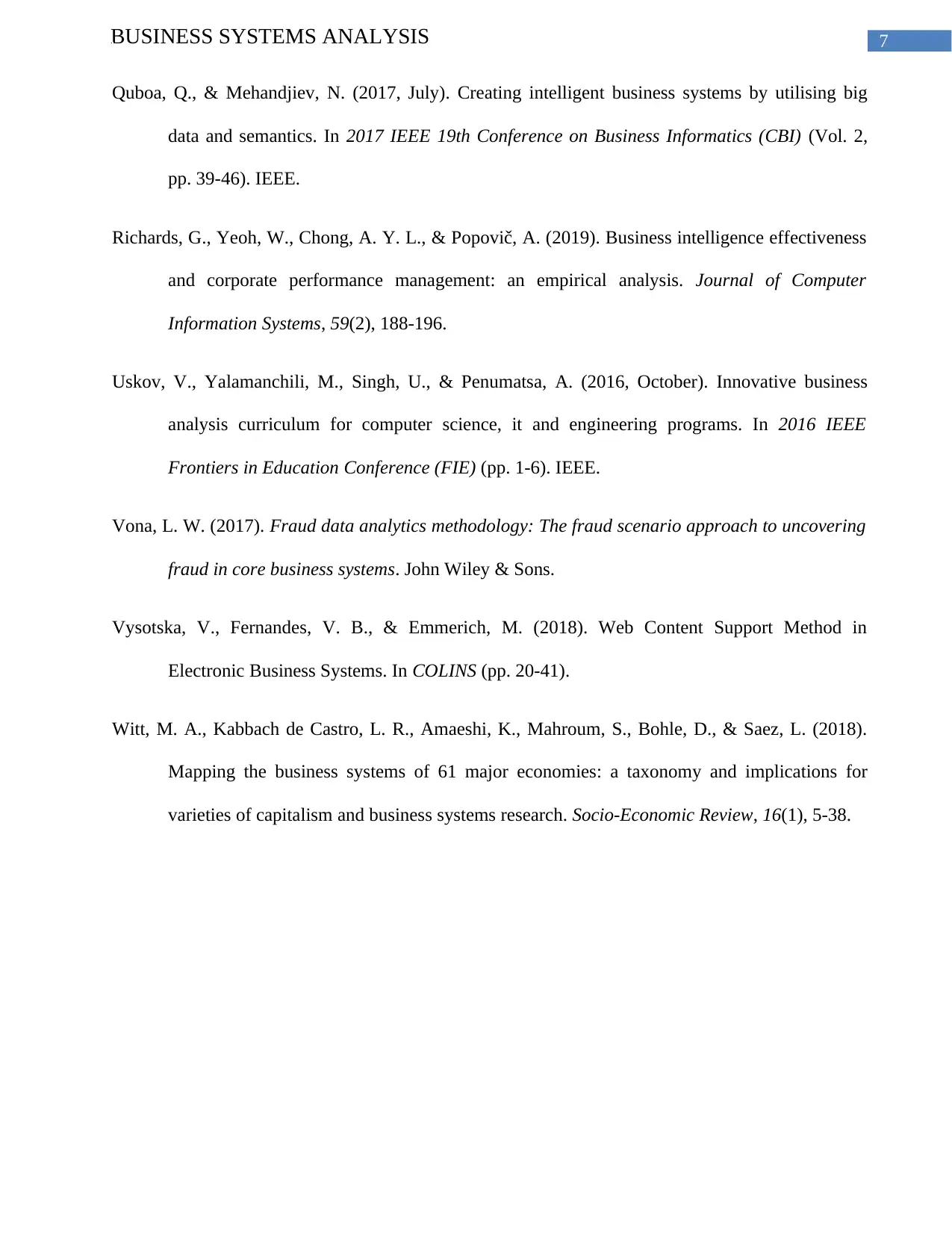
7BUSINESS SYSTEMS ANALYSIS
Quboa, Q., & Mehandjiev, N. (2017, July). Creating intelligent business systems by utilising big
data and semantics. In 2017 IEEE 19th Conference on Business Informatics (CBI) (Vol. 2,
pp. 39-46). IEEE.
Richards, G., Yeoh, W., Chong, A. Y. L., & Popovič, A. (2019). Business intelligence effectiveness
and corporate performance management: an empirical analysis. Journal of Computer
Information Systems, 59(2), 188-196.
Uskov, V., Yalamanchili, M., Singh, U., & Penumatsa, A. (2016, October). Innovative business
analysis curriculum for computer science, it and engineering programs. In 2016 IEEE
Frontiers in Education Conference (FIE) (pp. 1-6). IEEE.
Vona, L. W. (2017). Fraud data analytics methodology: The fraud scenario approach to uncovering
fraud in core business systems. John Wiley & Sons.
Vysotska, V., Fernandes, V. B., & Emmerich, M. (2018). Web Content Support Method in
Electronic Business Systems. In COLINS (pp. 20-41).
Witt, M. A., Kabbach de Castro, L. R., Amaeshi, K., Mahroum, S., Bohle, D., & Saez, L. (2018).
Mapping the business systems of 61 major economies: a taxonomy and implications for
varieties of capitalism and business systems research. Socio-Economic Review, 16(1), 5-38.
Quboa, Q., & Mehandjiev, N. (2017, July). Creating intelligent business systems by utilising big
data and semantics. In 2017 IEEE 19th Conference on Business Informatics (CBI) (Vol. 2,
pp. 39-46). IEEE.
Richards, G., Yeoh, W., Chong, A. Y. L., & Popovič, A. (2019). Business intelligence effectiveness
and corporate performance management: an empirical analysis. Journal of Computer
Information Systems, 59(2), 188-196.
Uskov, V., Yalamanchili, M., Singh, U., & Penumatsa, A. (2016, October). Innovative business
analysis curriculum for computer science, it and engineering programs. In 2016 IEEE
Frontiers in Education Conference (FIE) (pp. 1-6). IEEE.
Vona, L. W. (2017). Fraud data analytics methodology: The fraud scenario approach to uncovering
fraud in core business systems. John Wiley & Sons.
Vysotska, V., Fernandes, V. B., & Emmerich, M. (2018). Web Content Support Method in
Electronic Business Systems. In COLINS (pp. 20-41).
Witt, M. A., Kabbach de Castro, L. R., Amaeshi, K., Mahroum, S., Bohle, D., & Saez, L. (2018).
Mapping the business systems of 61 major economies: a taxonomy and implications for
varieties of capitalism and business systems research. Socio-Economic Review, 16(1), 5-38.
1 out of 8
Related Documents
Your All-in-One AI-Powered Toolkit for Academic Success.
+13062052269
info@desklib.com
Available 24*7 on WhatsApp / Email
![[object Object]](/_next/static/media/star-bottom.7253800d.svg)
Unlock your academic potential
Copyright © 2020–2025 A2Z Services. All Rights Reserved. Developed and managed by ZUCOL.





